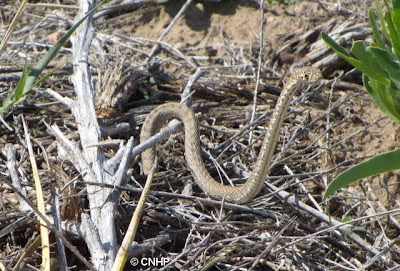By Bernadette Kuhn, CNHP Botanist
We recently headed out to the Comanche National Grasslands to conduct research on grazing exclosures in sand-sage prairie occupied by Lesser Prairie Chicken. This species is a Candidate for listing under the Endangered Species Act. Decline of the species has been attributed to habitat degradation and fragmentation, and numbers of individuals are estimated at less than 300. The goal of our study is to determine if the vegetation in grazing exclosures meets the desirable conditions for Lesser Prairie Chicken habitat, as described by biologist Ken Giesen. Many of the exclosures were created in 1961 to provide habitat for scaled quail.
 |
| Lee Gruneau (CNHP) and Steve Olson (USFS) record vegetation height along a transect in sandsage prairie, Comanche National Grasslands. |
Although we did not observe any Lesser Prairie Chickens, we were lucky enough to spot a juvenile coachwhip during our trip.
 |
| A curious juvenile coachwhip (Masticophis flagellum) raises its head to check us out. |
We started our fieldwork on the heels of a rainstorm, so floral displays in the sandsage prairie were impressive. Lee and Renée spotted a Texas horned lizard and an ornate box turtle underneath the cover of blooming forb species.
 |
| A Texas horned lizard (Phrynosoma cornutum) peeks out of the orange flowers of globemallow (Sphaeralcea coccinea) and the yellow-petaled (Zinnia grandiflora). |
 |
| This tiny Ornate box turtle (Terrapenne ornata) was hiding under a Russian thistle tumbleweed (Salsola tragus). |
This is a multi-year study in collaboration with the U.S. Forest Service, and the results will help biologists on the Comanche manage this area for Lesser Prairie Chicken habitat.
 |
| Stephanie Shively, USFS wildlife biologist, guides a meter tape underneath the exclosure fence. |








No comments:
Post a Comment
Thanks for your comment!
Please note that all comments are moderated, so there may be a delay of some hours (especially over the weekend or at night Colorado time) before your comment shows up.